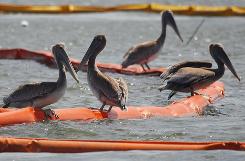 http://www.usatoday.com/news/nation/2010-07-22-storm-approaches-gulf-oil_N.htm
http://www.usatoday.com/news/nation/2010-07-22-storm-approaches-gulf-oil_N.htm
Image By Chris Graythen, Getty Images
Pelicans sit on boom that is protecting Queen Bess Island on Wednesday in Grand Isle, Louisiana. A possible storm that may head into the Gulf of Mexico where BP is drilling a relief well would suspend oil spill containment projects.
ON THE GULF OF MEXICO (AP) — Dozens of ships were preparing Thursday to pull out of the Gulf of Mexico as a tropical storm brewed in the Caribbean, halting deep-sea efforts to plug BP’s ruptured oil well.
Though the rough weather was hundreds of miles (kilometers) from the spill site, officials ordered technicians to suspend work Wednesday as they would need several days to clear the area. The government’s oil spill chief was waiting to see how the storm developed before deciding whether to order the ships to evacuate.
Anxiety was building among the 75-member crew aboard the cutter Decisive, the Coast Guard’s primary search and rescue vessel, which would be the last of about 65 ships to leave in the event of an evacuation.
“It’s a controlled chaos out there,” Lt. Patrick Montgomery told an Associated Press reporter aboard the cutter heading to the spill site from Pascagoula, Mississippi.
The technicians were forced to halt their work just days from completing a relief well to permanently throttle the free-flowing crude.
Worse yet, foul weather could require reopening the cap that has contained the oil for nearly a week, allowing oil to gush into the sea again while engineers wait out the storm.
“This is necessarily going to be a judgment call,” said retired Coast Guard Adm. Thad Allen, the government’s point man on the crisis, on Wednesday.
The cluster of thunderstorms passed over Haiti and the Dominican Republic on Wednesday, and was forecast to move into the Gulf over the weekend with a 40% chance it would becoming a tropical depression or tropical storm by Friday.
Crews stationed some 50 miles (80 kilometers) out in the Gulf had planned to spend Wednesday and Thursday reinforcing with cement the last few feet (meters) of the relief tunnel that will be used to pump mud into the gusher and block it once and for all. But BP instead placed a temporary plug called a storm packer inside the tunnel in case it has to be abandoned while the storm passes.
“What we didn’t want to do is be in the middle of an operation and potentially put the relief well at some risk,” BP vice president Kent Wells said.
If the work crews are evacuated, it could be two weeks before they can resume the effort to plug the well. That would upset BP’s timetable for finishing the relief tunnel this month and plugging the blown-out well by early August.
Scientists have been scrutinizing underwater video and pressure data for days, trying to determine if the capped well is holding tight or in danger of rupturing and causing an even bigger disaster. If the storm prevents BP from monitoring the well, the cap may simply be reopened, allowing oil to spill into the water, Allen said.
BP and government scientists were discussing whether the cap could be monitored from shore.
As the storm drew closer, boat captains hired by BP for skimming duty were sent home for five or six days, said Tom Ard, president of the Orange Beach Fishing Association in Alabama.
In Florida, crews removed booms protecting the Panhandle’s waterways, as high winds and storm surges could carry the booms into sensitive wetlands.
Also, Shell Oil began evacuating employees out in the Gulf.
The storm could affect oil containment and cleanup efforts even if it does not hit the area directly. Last month, Hurricane Alex stayed 500 miles (805 kilometers) away but skimming in Alabama, Mississippi and Florida was curtailed for nearly a week.
The relief tunnel extends about 2 miles (3 kilometers) under the seabed and is about 50 to 60 feet (15 to 18 meters) vertically and 4 feet (1.2 meters) horizontally from the ruptured well. BP plans to cement a final string of casing, or drilling pipe, into place and give it up to a week to set before attempting to punch through to the blown-out well and kill it.
BP’s broken well spewed between 94 million and 184 million gallons (356 million to 697 million liters) before the cap was attached. The crisis — the biggest offshore oil spill in U.S. history — unfolded after the BP-leased Deepwater Horizon rig exploded April 20, killing 11 workers.
The cause of the blast is still under investigation, but rig workers have repeatedly questioned the rig’s equipment and safety conditions.
The New York Times reported early Thursday that rig workers expressed concern in a confidential survey before the blast about safety and the condition of equipment.
The Times said another report for Transocean by Lloyd’s Register Group found that several pieces of equipment — including the rams in the failed blowout preventer on the well head — had not been inspected since 2000, despite guidelines calling for inspection every three to five years. Transocean said most of the equipment was minor and the blowout preventer was inspected by manufacturer guidelines.
A spokesman for Transocean, the owner of the rig leased by BP, confirmed the existence of the reports to The Associated Press.
“As part of Transocean’s unwavering commitment to safety and rigorous maintenance discipline on all our rigs, we proactively commissioned the safety survey and the rig assessment review,” Transocean spokesman Lou Colasuonno said in an e-mail Thursday. “A fair reading of those detailed third-party reviews indicates clearly that while certain areas could be enhanced, overall rig maintenance met or exceeded regulatory and industry standards and the Deepwater Horizon’s safety management was strong and a culture of safety was robust on board the rig.”